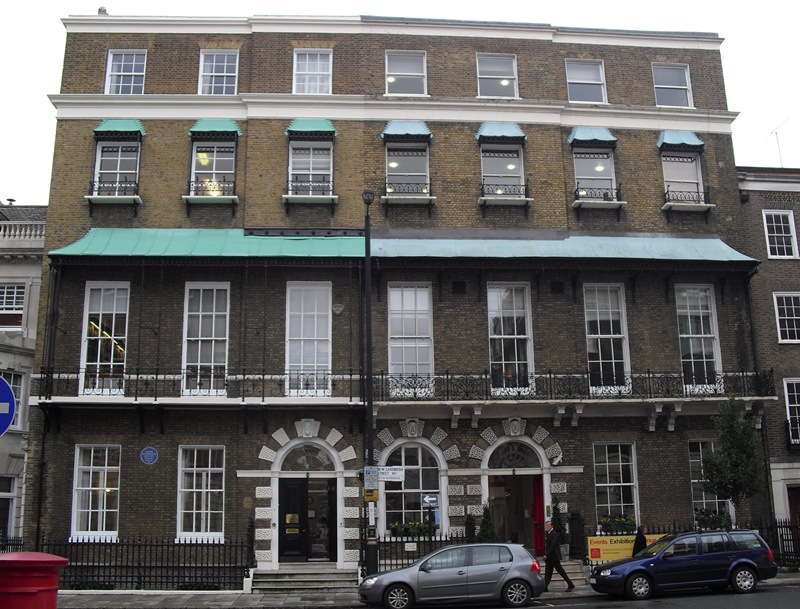For the next in her series discussing Robert and James Adam’s work in London Dr Frances Sands will focus on the unexecuted scheme for Portland House on New Cavendish Street.
William Henry Cavendish-Bentinck (1738-1809) was a notable statesman. He served as MP for Weobley, Herefordshire, in 1761-62, when he succeeded his father as the 3rd Duke of Portland, and entered the House of Lords as a Whig. From this time he was extremely active in public life. From 1764 he took up the family sinecure as a trustee of the British Museum; in 1765-66 he served as Lord Chamberlain; in 1766 he became a Fellow of the Royal Society; in 1775 he became a Fellow the Society of Antiquaries; in 1782 he served as Lord Lieutenant of Ireland; in 1783 he served briefly as Prime Minister; in 1794 he was made a Knight of the Garter, and began his service as Home Secretary which lasted until 1801; and in 1807-9 he served again as Prime Minister, resigning only shortly before his death.
Being such an active politician, the 3rd Duke of Portland resided mainly in London. In 1766 he had married Lady Dorothy Cavendish, the daughter of the 4th Duke of Devonshire, enabling him to send the majority of his time in town living at Devonshire House. This was just as well, because his own London townhouse within the grounds of Whitehall was meagre and in ill repair. The Whitehall plot had been leased from the crown by the Portland family since 1696, as their apartments within the palace had been severely damaged by the fire in 1691. Repairs and alterations were necessary by 1754-55, and made to designs by Stiff Leadbetter (died 1766) for the 2nd Duke. These works must have been inadequate, however, as during the first half of the 1770s the 3rd Duke commissioned Robert Adam to make designs for a grandiose new palace – Portland House – located on New Cavendish Street, and facing the end of Mansfield Street.
We can see from eight surviving drawings at the Soane Museum that Adam proposed a building that was more to the scale of a country mansion than a London townhouse. It was to be thirteen bays wide, and set between a large rectangular walled garden, and a large circular stable court giving access to an elaborate gateway, with New Cavendish Street beyond. There are even surviving drawings for a pair of chimneypieces.
Mansfield Street had been laid out by the Adam brothers in c.1770, and it was immediately following this that the designs were made to replace Portland’s meagre house at Whitehall with this grand new palace. The new house was presumably intended to emphasise the 3rd Duke’s eminent political position, but nothing of Adam’s design for Portland House was executed. It is likely that the Duke could not afford the construction works. His fortune was severely limited by his mother’s generous portion, and his electoral campaigns were costly. Indeed, by 1805 he had been forced to surrender the lease on his Whitehall house, which was then demolished, and at the time of his death in 1809 the Duke was £500,000 in debt.
All ambitions to realise Adam’s grandiose designs for Portland House were abandoned by the end of 1776, when a pair of terraced houses were built on the plot to designs by John Johnson (1732-1814) for William Udney and Sir Charles Bampfylde. These two houses – previously numbers 9 and 10 – are now designated as numbers 61 and 63 New Cavendish Street, and both are in good repair. Number 61 is currently the location of the Energy Institute, and number 63 is Asia House.
By the end of 2013, 4000 drawings from the Adam collection will be available to view Collections Online. Dr Frances Sands continues her work to make the remaining drawings collection digitally available.
As part of the Museum’s programme of digitization and improved access to collections the Adam drawings will also be amongst the 50,000 – 60,000 works of art, books and drawings, plus the Soane Archive to be transferred into the Collections Index+ Collections Management System (CMS) that will for the first time ever allow the Museum to store and sort records of all the items in the Museum’s collection. This has been made possible with thanks to funding from the HLF and an additional year’s funding by the Arts Council England’s Designation Development Fund for the collections information to become available to the public, starting from late 2013.


